Orca
| Orca whale[1] | |
|---|---|

| |
| Transient killer whales near Unimak Island, eastern Aleutian Islands, Alaska | |
| Scientific classification | |
| Kingdom: | |
| Phylum: | |
| Class: | |
| Order: | |
| Suborder: | |
| Family: | |
| Genus: | Orcinus
|
| Species: | O. orca
|
| Binomial name | |
| Orcinus orca Linnaeus, 1758
| |

| |
| Orcinus orca range (in blue) | |
| Synonyms | |
|
Orca gladiator | |

The killer whale (Orcinus orca), commonly referred to as the orca – and, less commonly, blackfish – is the largest species of the oceanic dolphin family. They are found in all of the world's oceans, from the frigid Arctic and Antarctic regions to tropical seas. Killer whales as a species have a diverse diet, although populations often specialize in particular types of prey. Some feed exclusively on fish, while other populations hunt marine mammals such as sea lions, seals, walruses and even large whales. Killer whales are regarded as apex predators as they have no natural predators.
Researchers have identified five distinct killer whale types distinguished by geographical range, preferred prey and physical appearance. Some of these may be separate races, subspecies or even species. Killer whales are highly social; some populations are composed of matrilineal family groups which are the most stable of any animal species.[3] The sophisticated hunting techniques and vocal behaviours of killer whales, which are often specific to a particular group and passed from one generation to the next, have been described as manifestations of culture.
The IUCN currently assesses the conservation status of the killer whale as data deficient because of the likelihood that one or more killer whale types could actually be a separate species in need of protection. Some local populations are considered threatened or endangered due to depletion of prey species, habitat loss, pollution by PCBs, historic capture for marine mammal parks, and conflicts with fisheries. In late 2005, the killer whales known as the "southern resident killer whales" were placed on the U.S. Endangered Species list.
Wild killer whales are not considered a threat to humans,[4] although there have been cases of captive killer whales killing or injuring their handlers at marine theme parks. The killer whale features strongly in the mythologies of indigenous cultures. In Western cultures, it has had a reputation for being a fearsome predator, but in recent decades better understanding has led to widespread appreciation of the species.
Taxonomy and evolution
Orcinus orca is the only recognized species in the genus Orcinus, one of many animal species originally described by Linnaeus in 1758 in Systema Naturae.[5] Konrad Gessner wrote the first scientific description of a killer whale in his "Fish book" of 1558, based on examination of a dead stranded animal in the Bay of Greifswald that had attracted a great deal of local interest.[6]
The killer whale is one of 35 species in the oceanic dolphin family, which first appeared about 11 million years ago. The killer whale lineage probably branched off shortly thereafter.[4] Although it has morphological similarities with pilot whales and pygmy killer whales, its closest relative is the Irrawaddy dolphin.[7]
Common names
English-speaking scientists most often use the term killer whale,[8] although the term orca is increasingly used. Killer whale advocates point out that it has a long heritage. Indeed, the genus name Orcinus means "of or belonging to the kingdom of the dead",[8] and although the name orca (in use since antiquity) is probably not etymologically related, the assonance might have given some people the idea that it meant "whale that brings death" or "demon from hell." The name is also similar to Orcus, a Roman god of the underworld.
Ancient Romans originally applied orca (plural orcae) to these animals, possibly borrowing it from the Greek ὄρυξ, which referred (among other things) to a whale species. Since the 1960s, orca has steadily grown in popularity; both names are now used. The term orca is preferred by some to avoid the negative connotations of "killer",[9] and because the species is more closely related to dolphins than to whales.
They are sometimes referred to as blackfish, a name used for some whale species as well. Grampus is a former name for the species, but is now seldom used. This meaning of grampus should not be confused with the Grampus genus, whose only member is Risso's Dolphin.[10]
Types
There are three to five types of killer whales that may be distinct enough to be considered different races,[11] subspecies, or possibly even species.[12] The IUCN reported in 2008, "The taxonomy of this genus is clearly in need of review, and it is likely that O. orca will be split into a number of different species or at least subspecies over the next few years."[2] In the 1970s and 1980s, research off the west coast of Canada and the United States identified the following three types:
- Resident: These are the most commonly sighted of the three populations in the coastal waters of the northeast Pacific. Residents' diet consists primarily of fish and sometimes squid, and they live in complex and cohesive family groups.[13] Female residents characteristically have a rounded dorsal fin tip that terminates in a sharp corner.[14] They are known to visit the same areas consistently. British Columbia and Washington resident populations are amongst the most-intensively studied marine mammals. Researchers have identified and named over 300 killer whales over the past 30 years.[15]
- Transient: The diet of these whales consists almost exclusively of marine mammals; they do not eat fish.[14] Transients generally travel in small groups, usually of two to six animals, and have less persistent family bonds than residents. Transients vocalize in less variable and less complex dialects. Female transients are characterized by more triangular and pointed dorsal fins than those of residents.[14] The gray or white area around the dorsal fin, known as the "saddle patch," often contains some black colouring in residents. However, the saddle patches of transients are solid and uniformly gray.[14] Transients roam widely along the coast—some individuals have been sighted in both southern Alaska and California.[16]
- Offshore: A third population of killer whales in the northeast Pacific was discovered in 1988 when humpback whale researcher Jim Darling informed killer whale researchers Michael Bigg and Graeme Ellis that he saw some in open water. As suggested by their name, they travel far from shore and are believed to feed primarily on schooling fish.[17] However, because of the large presence of scarred and nicked dorsal fins resembling that of the mammal-hunting transients, the possibility that they eat mammals and sharks cannot be dismissed. They have mostly been encountered off the west coast of Vancouver Island and near the Queen Charlotte Islands. Offshores typically congregate in groups of 20–75 animals with occasional sightings of larger groups of up to 200 specimens.[18] Currently, little is known about their habits, but they can be distinguished genetically from residents and transients. Offshores appear to be smaller than residents or transients, and females are characterized by dorsal fin tips that are continuously rounded.[14]
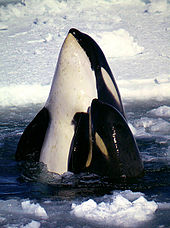
Transient and resident killer whales live in the same areas, but avoid each other.[19] The name transient originated from the belief that these killer whales were outcasts from larger resident pods. Researchers later discovered that transients are not born into resident pods or vice-versa. The evolutionary split between the two groups is believed to have begun two million years ago.[20] Genetic research indicates that the types have not interbred for up to 10,000 years.[21]
Killer whale populations in other parts of the world have not been as well studied, although specialized fish-eating and mammal-eating killer whales have also been distinguished elsewhere.[22] Separate populations of fish-eating and mammal-eating killer whales have been identified around the United Kingdom.[23][24] Fish-eating killer whales in Alaska and Norway have been observed to have resident-like social structures, while mammal-eating killer whales in Argentina and the Crozet Islands have been observed to behave more like transients.[25]
Three killer whale types have recently been documented in the Antarctic. Two dwarf species, named Orcinus nanus and Orcinus glacialis, were described during the 1980s by Soviet researchers, but most cetacean researchers were skeptical about their status, and it is difficult to link these directly to the types described below.[12]
- Type A looks like a "typical" killer whale, a large, black and white form with a medium-sized white eye patch, living in open water and feeding mostly on minke whales.[12]
- Type B is smaller than Type A. It has a large white eye patch. Most of the dark parts of its body are medium gray instead of black, although it has a dark gray patch called a "dorsal cape"[26] stretching back from its forehead to just behind its dorsal fin. The white areas are stained slightly yellow. It feeds mostly on seals.[12]
- Type C is the smallest type and lives in larger groups than any other type. Its eye patch is distinctively slanted forwards, rather than parallel to the body axis. Like Type B, it is primarily white and medium gray, with a dark gray dorsal cape and yellow-tinged patches. Its only observed prey is the Antarctic Cod.[12]
Types B and C live close to the Antarctic ice pack, and diatoms in these waters may be responsible for the yellowish colouring of both types.[12][27] Mitochondrial DNA sequences support the theory that these are separate species that have recently diverged.[28]
Research is ongoing into the genetic relationships between killer whale types, and whether the types that have been identified represent deep evolutionary trends. For example, it was long presumed that mammal-eating killer whales were likely to be closely related to other mammal-eating killer whales from different regions, but genetic testing has found that this is not the case.[29]
Description

Killer whales are distinctively marked with a black back, white chest and sides, and a white patch above and behind the eye. Calves are born with a yellowish or orange tint, which fades to white. Killer whales have a heavy and robust body (more so than other dolphins)[30] and a large dorsal fin up to 2 metres (6.6 ft) tall. Behind the fin, they have a dark grey "saddle patch" across the back. Antarctic killer whales may have pale grey to nearly white backs. Adult killer whales are very distinctive and are unlikely to be confused with any other sea creature.[31] When seen from a distance, juveniles can be confused with other cetacean species such as the false killer whale or Risso's dolphin.
Males typically range from 6 to 8 metres (20–26 ft) long and weigh in excess of 6 tonnes (5.9 long tons; 6.6 short tons).[32] Females are smaller, generally ranging from 5 to 7 metres (16–23 ft) and weighing about 3 to 4 tonnes (3.0 to 3.9 long tons; 3.3 to 4.4 short tons).[32] The largest male killer whale on record was 9.8 metres (32 ft), weighing over 10 tonnes (9.8 long tons; 11 short tons), while the largest female was 8.5 metres (28 ft), weighing 7.5 tonnes (7.4 long tons; 8.3 short tons).[33] Calves at birth weigh about Template:Kg to lb and are about 2.4 metres (7.9 ft) long.[34][35] The killer whale's large size and strength make it among the fastest marine mammals, able to reach speeds in excess of 30 knots (56 km/h).[36]
Killer whale pectoral fins are large and rounded, resembling paddles. Males have significantly larger pectoral fins than females. At about 1.8 metres (5.9 ft) the male's dorsal fin is more than twice the size of the female's and is more of a triangular shape – a tall, elongated isosceles triangle – whereas hers is shorter and more curved.[37] Males and females also have different patterns of black and white skin in the genital area.[38]
Individual killer whales can often be identified by a good view of the dorsal fin and saddle patch. Variations such as nicks, scratches, and tears on the dorsal fin and the pattern of white or grey in the saddle patch are unique. Published directories contain identifying photographs and names for hundreds of North Pacific animals. Photo identification has enabled the local population of killer whales to be counted each year rather than estimated and has enabled great insight into lifecycles and social structures.[39]
White killer whales occur sporadically among normal killerwhales, but are rare. They have been spotted in the northern Bering Sea and around St. Lawrence Island, and near the Russian coast. In February 2008, a white killer whale was photographed Template:Mi to km off Kanaga Volcano.[40][41]
Killer whales have good eyesight above and below the water, excellent hearing, and a good sense of touch. They have exceptionally sophisticated echolocation abilities, detecting the location and characteristics of prey and other objects in their environment by emitting clicks and listening for echoes.[42]
Life cycle
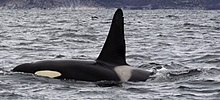
Female killer whales become mature at around age 15. Then they have periods of polyestrous cycling with non-cycling periods of between 3 and 16 months. The gestation period varies from 15 to 18 months. Mothers calve, with usually a single offspring, about once every 5 years. In resident pods, birth occurs at any time of year, although winter is the most popular. Mortality is extremely high during the first six months of life, when 37–50% of all calves die.[43] Calves start being weaned at about 12 months and are fully weaned by the age of two years. According to observations in several regions, all male and female killer whale pod members participate in the care of the young.[44]
Females breed until age 40, meaning that on average they raise five offspring. The lifespan of wild females averages 50 years, with a maximum of 80–90 years.[45] Males become sexually mature at the age of 15 but do not typically reproduce until age 21. Wild males live around 29 years on average, with a maximum of 50–60 years.[45] One male, known as Old Tom, was reportedly spotted every winter between the 1840s and 1930 off New South Wales, Australia. This would have made him up to 90 years old. Examination of his teeth indicated he died around age 35,[46] but this method is now believed to be inaccurate for older animals.[47] One male well known to researchers in the Pacific Northwest called Ruffles (J1) is estimated to have been born in 1951, making him 58 years old in 2009.[48] Captive killer whale lifespans are typically significantly shorter, usually less than 25 years; however, there are numerous individuals in their thirties, and a couple in their 40s. In many instances, the lifespans of killer whales depend on the will of the animal.[49][50]
Range and habitat
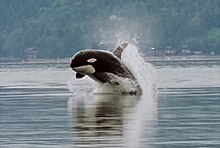
Killer whales are found in all oceans and most seas, including (unusually for cetaceans) the Mediterranean and Arabian Seas. However, they prefer cooler temperate and polar regions. Although sometimes spotted in deep water, they generally prefer coastal areas to pelagic environments.[51] Information for offshore regions and tropical waters is more scarce, but widespread, if not frequent, sightings indicate that the killer whale can survive in most water temperatures. The regions where killer whales are most abundant are in the North Atlantic near Norway, the North Pacific around the Aleutian Islands and the Gulf of Alaska, and in the Southern Ocean around Antarctica.[52]
The largest population lives in Antarctic waters, where they range up to the ice pack and are believed to venture under the pack, surviving by breathing in air pockets as do beluga whales in the Arctic. Killer whales visit Arctic waters in summer, but are rarely seen in winter and do not approach the ice pack. With the rapid Arctic sea ice decline in the Hudson Strait, their range now extends into Canada's far northern waters. In the 1990s, killer whales were sighted in western Hudson Bay only 6 times; there were over 30 sightings from 2001–2006.[53]
Worldwide population estimates are uncertain, but one recent study estimated more than 50,000.[18] Local estimates include roughly 25,000 in the Antarctic, 8,500 in the tropical Pacific, 2,250–2,700 off the cooler northeast Pacific and 500–1,500 off Norway.[54] Japan's Fisheries Agency estimated there were 2,321 killer whales in the seas around Japan.[55][56]
Killer whales' migration patterns are poorly understood. Each summer, the same resident killer whales appear off the coasts of British Columbia and Washington State. After decades of research, it is still unknown where these animals go for the rest of the year. Transient pods have been sighted from southern Alaska to central California.[57]
Occasionally, killer whales have been known to swim into freshwater rivers. They have been documented Template:Mi to km up the Columbia River in the United States.[58][59] They have also been found in the Fraser River in Canada and the Horikawa River in Japan.[58]
Feeding
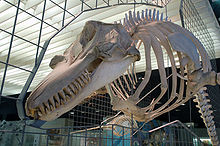
Killer whales prey on many different species, however, populations tend to show a high degree of specialization. For example, some populations in the Norwegian and Greenland sea specialize in herring and follow that fish's autumnal migration to the Norwegian coast. Other populations prey on seals. Field observations of northeast Pacific resident killer whales show that salmon accounted for 96% of their diet, with 65% of salmon prey being the large, fatty Chinook.[60] Chum salmon are also eaten, but smaller sockeye and pink salmon are not a significant food item.[61] Depletion of specific prey species in an area is therefore cause for concern for local populations, despite the high diversity of prey. On average, a killer whale eats Template:Kg to lb each day.[62]
Since some killer whales prey on large whales and sharks, they are considered to be apex predators. They are sometimes called the wolves of the sea, because they hunt in groups like wolf packs.[63]
Fish and other cold-blooded prey
Fish-eating killer whales prey on around 30 species of fish, particularly Chinook salmon, herring, and tuna. In New Zealand, rays are killer whales' most frequent prey,[64] and they have also been observed hunting sharks (particularly makos, threshers and smooth hammerheads). Squid and sea turtles are also taken.[65]
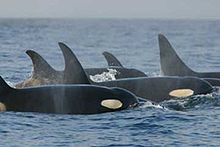
Killer whales can induce tonic immobility in sharks and rays by holding them upside down, rendering them helpless and incapable of injuring the whale. Some sharks will suffocate within about 15 minutes when held still because these sharks need to be moving to breathe. In one incident filmed near the Farallon Islands, a female killed a 3–4-metre (9.8–13.1 ft) long great white shark,[66] apparently after swimming with it upside-down in her mouth and inducing tonic immobility in it. She and another pod member ate the shark's nutritious liver and allowed the rest of the carcass to sink.[67]
In July 1992, two killer whales attacked, killed and fed on an 8-metre (26 ft) long whale shark, Rhincodon typus, in the waters off Bahia de los Angeles in Baja California.[68]
While salmon are usually hunted by a single or small group of individuals, herring are often caught using carousel feeding: the killer whales force the herring into a tight ball by releasing bursts of bubbles or flashing their white undersides. They then slap the ball with their tail flukes, either stunning or killing up to 10–15 herring with a successful slap. The herring are then eaten one at a time. Carousel feeding has only been documented in the Norwegian killer whale population and with some oceanic dolphin species.[69]
Mammal prey

Killer whales are strikingly sophisticated and effective predators. Twenty-two cetacean species have been recorded as killer whale prey, from examining either stomach contents, scarring on the prey's body, or feeding activity. Groups even attack larger cetaceans such as minke whales, gray whales, and rarely sperm whales or blue whales.
Hunting large whales usually takes several hours, and killer whales generally choose to attack young or weak whales. However, a group of five or more may attack healthy adults. When hunting a young whale, a group chases it and its mother until they wear out. Eventually they separate the pair and surround the young whale, preventing it from surfacing to breathe. Whales are typically drowned in this manner. Pods of female sperm whales can sometimes protect themselves by forming a protective circle around their calves with their flukes facing outwards, using their powerful flukes to repel the attackers.[70]
Other marine mammal prey species include most species of seal, sea lion and fur seal. Walruses and sea otters are less frequently taken. Often, to avoid injury, killer whales disable their prey before killing and eating it. This may involve throwing it in the air, slapping it with their tails, ramming it, or breaching and landing on it.[71] Sea lions are killed by head-butting or after a stunning blow from a tail fluke. They occasionally throw seals into the air in order to stun and kill them. In the Aleutian Islands, a decline in sea otter populations in the 1990s was controversially attributed by some scientists to killer whale predation, although there is no direct evidence that killer whales were responsible.[72] The decline of sea otters followed a decline in harbour seal and Steller sea lion populations, the killer whale's preferred prey,[73][74] which in turn may be substitutes for their original prey, now decimated by industrial whaling.[75][76][77]
In steeply banked beaches off Península Valdés, Argentina, and the Crozet Islands, killer whales feed on South American sea lions and Southern elephant seals in shallow water, even beaching themselves temporarily to grab their prey before wriggling back to the sea. Beaching, usually fatal to cetaceans, is not an instinctive behaviour, and can require years of practice for young killer whales.[78]
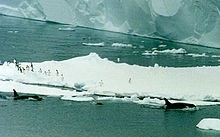
"Wave-hunting" killer whales spy-hop to locate Weddell seals, Ross seals, crabeater seals and leopard seals resting on ice floes and then swim in groups to create waves that wash over the floe. This washes the seal into the water where another killer whale waits to kill it.[79]
Killer whales have also been observed preying on terrestrial mammals, such as deer and moose swimming between islands off the northwest coast of North America.[80] Killer whale cannibalism has also been reported based on analysis of stomach contents, but this is likely to have been the result of scavenging the remains of whales dumped by whaling ships.[81] One killer whale was also attacked by its companions after being shot.[22] Although resident killer whales have never been observed to eat other marine mammals, they occasionally harass and kill porpoises and seals for no apparent reason.[82]
Birds
Killer whales in many areas have been observed to prey on several bird species, including penguins, cormorants and gulls.[83] A captive killer whale at Marineland discovered that it could regurgitate fish onto the surface, attracting sea gulls, and then eat the birds. Four other killer whales then learned to copy the behaviour.[84]
Behavior
Day-to-day killer whale behaviour generally consists of foraging, travelling, resting and socializing. Killer whales are frequently active at the surface, engaging in acrobatic behaviours such as breaching, spyhopping, and tail-slapping. These activities may have a variety of purposes, such as courtship, communication, dislodging parasites, or play. Spyhopping, a behaviour in which a whale holds its head above water, helps the animal view its surroundings.[85]
Resident killer whales swim with porpoises, other dolphins, seals, and sea lions, which are common prey for transient killer whales. Resident killer whales sometimes travel as much as 160 kilometres (100 mi) in a day, but may be seen in a general area for a month or more. Resident killer whale pod ranges vary from 320 to 1,300 kilometres (200 to 810 mi).
Social structure
Killer whales are noted for their richly complex societies. Only elephants and higher primates, such as humans, live in comparably complex social structures.[44] Resident killer whales in the eastern North Pacific have a particularly complex and stable social grouping system. Unlike any other mammal species whose social structure is known, resident killer whales live with their mothers for their entire lives. Therefore, killer whale societies are based on matrilines consisting of the matriarch and her descendants who form part of the line, as do their descendants. The average size of a matriline is 5.5 animals.[86]
Because females can reach age 90, four generations may travel together. These matrilineal groups are highly stable. Individuals separate for only a few hours at a time, to mate or forage. With one exception, the killer whale named Luna, no permanent dispersal of an individual from a resident matriline has been recorded.[86]
Closely related matrilines form loose aggregations called pods, usually consisting of one to four matrilines. Unlike matrilines, pods may split up for weeks or months at a time.[86] DNA testing indicates that resident males nearly always mate with females from other pods.[87]

Clans are the next level of social structure for resident killer whales, and are composed of pods with similar dialects and common but older maternal heritage. Geographic ranges of clans overlap. Pods from different clans frequently intermingle.[86]
The final association layer, perhaps more arbitrary than the other, familial groupings, is called the community and is defined as a set of clans that regularly commingle. Clans within a community do not share vocal patterns.[88]
Transient pods are smaller than resident pods, consisting of one to four individuals. They typically consist of an adult female and one or two of her offspring. Males typically maintain stronger relationships with their mother than females. These bonds can extend well into adulthood. Unlike residents, extended or permanent dispersal of transient offspring from natal matrilines is common, with juveniles and adults of both sexes participating. Some males become “roving” males that do not form long-term associations, living alone while occasionally joining groups that contain reproductive females.[89] As in resident clans, transient community members share an acoustic repertoire, although regional differences in vocalizations have been noted.[90]
Vocalizations
| Multimedia relating to the Orca |
Like all cetaceans, killer whales depend heavily on underwater sound for orientation, feeding, and communication. Killer whales produce three categories of sounds: clicks, whistles, and pulsed calls. Clicks are believed to be used primarily for navigation and discriminating prey and other objects in the surrounding environment, but are also commonly heard during social interactions and may have a communicative function.[18]
Northeast Pacific resident groups tend to be much more vocal than transient groups in the same waters.[91] Residents feed primarily on salmon, whose hearing is too poor to detect killer whale calls at any significant distance. Residents make sounds to identify themselves when they approach another marine mammal.
Transient killer whales feed mainly on marine mammals. Because all marine mammals have excellent underwater hearing, the typical silence of transients is probably necessary to avoid detection by their prey.[91] They sometimes use a single click (called a cryptic click) rather than the long train of clicks observed in other populations.
All members of a resident pod use similar calls, known collectively as a dialect. Dialects are composed of specific numbers and types of discrete, repetitive calls. They are complex and stable over time. Call patterns and structure are distinctive within matrilines. Newborns produce calls similar to adults, but have a more limited repertoire.[90] Individuals likely learn their dialect through contact with their mother and other pod members.[92] For instance, family-specific calls have been observed more frequently in the days following a calf's birth, which may help the calf learn them.[93] Dialects are probably an important means of maintaining group identity and cohesiveness. Similarity in dialects likely reflects the degree of relatedness between pods, with variation building over time.[94]
Researchers have not determined whether calls have particular meanings or are associated with specific types of activity. Dialects of resident killer whale pods contain 7–17 (mean = 11) distinctive call types. Transient dialects are much different, having only 4–6 discrete calls, none of which are shared with residents. All members of the North American west coast transient community express the same basic dialect, although minor regional variation in call types is evident. Preliminary research indicates that offshore killer whales have group-specific dialects unlike those of residents and transients.[94]
Intelligence
Killer whales have the second-largest brains of all marine mammals.[95] They can be trained in captivity and are often described as intelligent animals,[96][97] although it is difficult to define exactly what intelligence is, or how to measure it, in a species whose environment and survival strategies are very different from those of humans.[97]
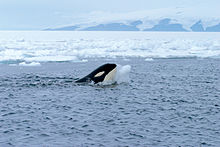
There are numerous examples of killer whales imitating behaviours of other killer whales, and examples in which killer whales seem to deliberately teach skills to their kin. This is most strikingly seen in the areas where killer whales deliberately beach themselves to catch seals. Off Península Valdés, adults sometimes pull seals off the shoreline and then release them again near juvenile whales, allowing the younger whales to practice the difficult capture technique on the now-weakened prey. Off the Crozet Islands, mothers have been seen pushing their calves onto the beach, waiting to pull the youngster back if needed.[71][98]
From people who have interacted closely with killer whales, there are numerous anecdotes demonstrating killer whales' curiosity, playfulness, and ability to solve problems. For example, killer whales in Alaska have not only learned how to steal fish from longlines, but have overcome a variety of techniques designed to dissuade them from the practice, such as the use of unbaited lines as decoys.[99] Once, fishermen tried working together by placing their boats several miles apart and taking turns to retrieve small amounts of their catch, in the hope that killer whales would dash between boats not have enough time to steal any fish as it was being retrieved. A researcher described what happened next:
"It worked really well for a while. Then the whales split into two groups. It didn't even take them an hour to figure it out. They were so thrilled when they figured out what was going on, that we were playing games. They were breaching by the boats."
— Craig Matkin[99]
In other anecdotes, researchers describe incidents in which wild killer whales playfully tease humans by repeatedly moving objects that the humans are trying to reach,[100] or suddenly start to toss around a chunk of ice after a human throws a snowball.[101]
The killer whale's use of dialects and the passing of other learned behaviours from generation to generation have been described as forms of culture.[102] The paper Culture in Whales and Dolphins goes as far as to say, "The complex and stable vocal and behavioural cultures of sympatric groups of killer whales (Orcinus orca) appear to have no parallel outside humans and represent an independent evolution of cultural faculties."[103]
Conservation

In 2008, the IUCN changed its assessment of the killer whale's conservation status from conservation dependent to data deficient, recognizing that one or more killer whale types may actually be separate, endangered species.[2] Depletion of prey species, pollution, large-scale oil spills, and habitat disturbance caused by noise and conflicts with boats are currently the most significant worldwide threats.[2]
Like other animals at the highest trophic levels of the food chain, the killer whale is particularly at risk of poisoning from accumulation of polychlorinated biphenyls (PCBs).[104] Harbour seals in Europe have been shown to have problems in reproductive and immune functions associated with high levels of PCBs and related contaminants, and survey off the Washington coast found that PCB levels in killer whales were higher than the levels that had caused health problems in harbour seals.[104] Samples from the blubber of killer whales in the Norwegian Arctic show higher levels of PCBs, pesticides and brominated flame-retardants than in polar bears. When food is scarce, killer whales must metabolize their blubber for energy, which increases pollutant concentrations.
In the Pacific Northwest, wild salmon stocks, a main food source for resident killer whales, have declined dramatically in recent years.[2] On the west coast of Alaska and the Aleutian Islands, seal and sea lion populations have also undergone a major decline.[105]
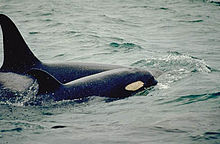
In 2005, the United States government listed the southern resident community as an endangered population under the Endangered Species Act.[106] The southern resident community comprises three pods which spend most of the year in the Georgia and Haro Straits and Puget Sound in British Columbia and Washington. They do not breed outside of their community, which was previously estimated at around 200 animals and had shrunk to around 90.[107] In October 2008, the annual survey revealed that seven were missing and presumed dead, reducing the count to 83.[108] This is potentially the largest decline in the population in the past ten years, described as a "disaster" by Ken Balcomb, a senior scientist at the Center for Whale Research. These deaths can be attributed to declines in chinook salmon.[108]

As killer whales rely on hearing for communication, navigation, and foraging, noise from shipping, drilling, and other human activities is a significant concern in some key areas of killer whale habitat, including Johnstone Strait and Haro Strait.[109] In the mid-1990s, loud underwater noises from salmon farms were used to deter seals. Killer whales also avoided the surrounding waters.[110] High-intensity sonar used by the Navy disturbs killer whales along with other marine mammals.[111] Killer whales are popular with whale watchers, which may stress the whales and alter their behaviour, particularly if boats approach too closely or block their line of travel.[112]
The Exxon Valdez oil spill had an adverse effect on killer whales in Prince William Sound and the Kenai Fjords region of Alaska. Eleven members (about half) of one Resident pod disappeared in the following year. The spill damaged salmon and other prey populations, which in turn damaged local killer whales. By 2009, scientists estimated the AT1 transient population (considered part of a larger population of 346 transients), numbered only 7 individuals and had not reproduced since the spill. This population is expected to become extinct.[113][114]
Relationship with humans
Indigenous cultures

The indigenous peoples of the Pacific Northwest Coast feature killer whales throughout their history, art, spirituality and religion. The Haida regarded killer whales as the most powerful animals in the ocean, and their mythology tells of killer whales living in houses and towns under the sea. According to these myths, killer whales took on human form when under water, and humans who drowned went to live with them.[115] For the Kwakwaka'wakw, the killer whale was regarded as the ruler of the undersea world, with sea lions for slaves and dolphins for warriors.[115] In Kwakwaka'wakw and Nuu-chah-nulth mythology, killer whales may embody the souls of deceased chiefs.[115] The Tlingit of southeastern Alaska regarded the killer whale as custodian of the sea and a benefactor of humans.[116]
The Maritime Archaic people of Newfoundland also had great respect for killer whales, as evidenced by stone carvings of them found in a 4,000 year old burial site at the Port au Choix National Historic Site.[117][118]
In the tales and beliefs of the Siberian Yupik people, killer whales are said to appear as wolves in winter, and wolves as killer whales in summer.[119][120][121][122] Killer whales are believed to assist their hunters in driving walrus.[123] Reverence is expressed in several forms: the boat represents the animal, and a wooden carving hung from the hunter's belt.[121] Small sacrifices such as tobacco are strewn into the sea for them.[123] Killer whales were believed to have helped the hunters even when in wolf guise, by forcing the reindeer to allow themselves to be killed.[122]
"Killer" stereotype
In Western cultures, killer whales were historically feared as dangerous, savage predators.[124] The first written description of a killer whale was given by Pliny the Elder in circa AD 70, who wrote, "Orcas (the appearance of which no image can express, other than an enormous mass of savage flesh with teeth) are the enemy of [other whales]... they charge and pierce them like warships ramming."[125]

There have been very few confirmed attacks on humans by wild killer whales, none of which has been fatal.[126] In one instance, killer whales tried to tip ice floes on which a dog team and photographer of the Terra Nova Expedition was standing.[127] There is speculation that the barking of the sled dogs may have sounded enough like seal calls to trigger the killer whale's hunting curiosity. In the 1970s, a surfer in California was bitten, and in 2005 a boy in Alaska who was splashing in a region frequented by harbour seals was bumped by a killer whale that apparently misidentified him as prey.[128] Unlike wild killer whales, captive killer whales are reported to have made nearly two dozen attacks on humans since the 1970s, some of which have been fatal.[129][130]
Competition with fishermen also led to killer whales being regarded as pests. In the waters of the Pacific Northwest and Iceland, the shooting of killer whales was accepted and even encouraged by governments.[124] As an indication of the intensity of shooting that occurred until fairly recently, about 25% of the killer whales captured in Puget Sound for aquaria through 1970 bore bullet scars.[131] The U.S. Navy claimed to have deliberately killed hundreds of killer whales in Icelandic waters in 1956.[132][133]
Modern Western attitudes
Western attitudes towards killer whales have changed dramatically in recent decades. In the mid 1960s and early 1970s, killer whales came to much greater public and scientific awareness, starting with the first live-capture and display of a killer whale known as Moby Doll, a resident whale that had been harpooned off Saturna Island in 1964.[124] So little was known about killer whales at the time that it was nearly two months before the whale's keepers discovered what food (fish) it was willing to eat. To the surprise of those who saw him, Moby Doll was a docile, non-aggressive whale that made no attempts to attack humans.[134]
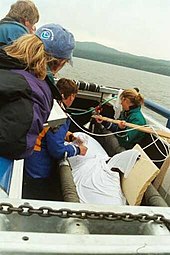
Between 1964 and 1976, 50 killer whales from the Pacific Northwest were captured for display in aquaria, and public interest in the animals grew. Millions of people gained an appreciation for killer whales by viewing them in captivity. In the 1970s, research pioneered by the late Michael Bigg led to the discovery of the species' complex social structure, its use of vocal communication, and its extraordinarily stable mother-offspring bonds. Through photo-identification techniques, individuals were named and tracked over decades.[135]
Bigg's techniques also revealed that the number of killer whales in the Pacific Northwest was small – in the low hundreds rather than the thousands that had been previously assumed.[124] The Southern Resident community alone had lost 48 of its members to captivity; by 1976, only 80 remained.[136] In the Pacific Northwest, the species that had previously been shot at unthinkingly became a cultural icon of the region within a few decades.[107]
The public's growing appreciation also led to growing opposition to the practice of keeping wild whales in aquaria. Only one whale has been taken in North American waters since 1976. In recent years, the extent of the public's interest in killer whales has manifested itself in several high-profile efforts surrounding individuals. Following the success of the 1993 film Free Willy, the movie's captive star Keiko was returned to the coast of his native Iceland. In 2002, the orphan Springer was discovered in Puget Sound, Washington. She became the first whale to be successfully reintegrated into a wild pod after human intervention, crystallizing decades of research into the vocal behaviour and social structure of the region's killer whales.[137] The saving of Springer raised hopes that another young killer whale named Luna who had become separated from his pod could be returned to it. His case was marked by controversy about whether and how to intervene, however, and in 2006 Luna was killed by a boat propeller.[138]
A popular Internet video shows a killer whale appearing to jump on a group of kayakers. The event shown is a fake used in an advertisement for a sports drink.[139][140]
Whaling

The first records of commercial hunting of killer whales date back to the 1700s in Japan. During the 19th and early 20th centuries, the global whaling industry harvested immense numbers of baleen and sperm whales, but largely ignored killer whales because of their limited amounts of recoverable oil, their smaller populations, and the difficulty that whalers had in capturing them.[87] Once the stocks of larger species were depleted, killer whales were targeted by commercial whalers in the mid twentieth century. Between 1954 and 1997, Japan took 1,178 killer whales and Norway took 987.[141] Over 3,000 killer whales were taken by Soviet whalers,[142] including an Antarctic catch of 906 in 1979 and 1980 alone, prompting the International Whaling Commission to recommend a ban on commercial hunting of the species pending further research.[141] Today, no country carries out a substantial hunt, although Indonesia and Greenland permit small subsistence hunts.
Killer whales have co-operated with humans in the hunting of other whales.[143] One well-known example were the killer whales of Eden, Australia, including the male known as Old Tom. Whalers more often considered them a nuisance, however, as they would gather to scavenge meat from the whalers' catch.[143] Some populations of killer whales, such as in Alaska's Prince William Sound, may have been reduced significantly by whalers shooting them in retaliation.[11]
Captivity
The killer whale's intelligence, trainability, striking appearance, playfulness in captivity and sheer size have made it a popular exhibit at aquariums and aquatic theme parks. Killer whales were taken from the coasts of British Columbia and Washington until 1976.[144] From 1976–1997, 55 whales were taken from the wild in Iceland, 19 from Japan, and three from Argentina. These figures exclude animals that died during capture.[144] Live captures fell dramatically in the 1990s, and by 1999, about 40% of the 48 animals on display in the world were captive-born.[144]
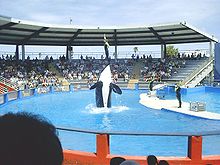
Organizations such as the World Society for the Protection of Animals and the Whale and Dolphin Conservation Society campaign against the practice of keeping them in captivity. Killer whales in captivity often develop pathologies, such as the dorsal fin collapse seen in 60–90% of captive males. Captive killer whales have vastly reduced life expectancies, on average only living into their 20s, though there are examples of killer whales living longer, including several over 30 years old, and two captive orcas (Corky II and Lolita) are in their mid-40s. In the wild, female killer whales who survive infancy live 50 years on average, and up to 70–80 years in rare cases. Wild males who survive infancy live 30 years on average, and up to 50–60 years.[145] The captive environment usually bears little resemblance to their wild habitat, and the social groups that the killer whales are put into are foreign to those found in the wild. Critics claim that captive life is stressful due to these factors and the requirement to perform circus tricks that are not part of wild killer whale behaviour.[146] Wild killer whales travel up to 160 kilometres (100 mi) each day, and critics say that the animals are too big and intelligent to be suitable for captivity.[96]
Captive killer whales occasionally act aggressively towards themselves, their tankmates, or humans, which critics say is a result of stress.[129][147][148] Tilikum, a captive killer whale born in the wild, has been involved in three fatalities including one in which he grabbed a trainer and pulled her underwater, eventually drowning her.[149] Experts are divided as to whether the injuries and deaths caused by captive killer whales have been accidents or deliberate attempts to cause harm.[149]
References
- ^ Mead, J. G.; Brownell, R. L. Jr. (2005). "Order Cetacea". In Wilson, D. E.; Reeder, D. M. (eds.). Mammal Species of the World: A Taxonomic and Geographic Reference (3rd ed.). Johns Hopkins University Press. pp. 723–743. ISBN 978-0-8018-8221-0. OCLC 62265494.
- ^ a b c d e Template:IUCN2008
- ^ Ford et al. (2000), p. 12.
- ^ a b Carwardine (2001), p. 19.
- ^ Template:La icon Linnaeus, C (1758). Systema naturae per regna tria naturae, secundum classes, ordines, genera, species, cum characteribus, differentiis, synonymis, locis. Tomus I. Editio decima, reformata. Holmiae. (Laurentii Salvii). p. 824.
- ^ a b Zum Wal in der Marienkirche (in German). St. Mary's Church, Greifswald. Retrieved 2010-02-16.
- ^ Wiles, Gary J. (2004). Washington State status report for the killer whale. Washington Department of Fish and Wildlife. Retrieved 2010-01-10.
- ^ a b Ford et al. (2000), p. 69.
- ^ Olsen, Ken. Orcas on the Edge – Killer: It’s a Name, Not an Accusation. National Wildlife Federation. January 10, 2006. Retrieved 2010-01-26.
- ^ Leatherwood, Stephen and Larry J. Hobbs (1988). Whales, dolphins, and porpoises of the eastern North Pacific and adjacent Arctic waters: a guide to their identification, p. 118. Courier Dover Publications. ISBN 0486256510, 9780486256511. Google Book Search. Retrieved 2010-01-28.
- ^ a b Baird, R. W. 1999. Status of Killer Whales in Canada. Contract report to the Committee on the Status of Endangered Wildlife in Canada, Ottawa, ON, Canada. Also published as Status of Killer Whales, Orcinus orca, in Canada The Canadian Field-Naturalist 115(4) (2001), 676–701. Retrieved 2010-01-26.
- ^ a b c d e f Pitman, Robert L. and Ensor, Paul (2003). Three forms of killer whales (Orcinus orca) in Antarctic waters, Journal of Cetacean Research and Management, 5(2):131–139.
- ^ Berta, Annalisa (2006). Marine mammals: evolutionary biology. Academic Press. p. 387. ISBN 9780120885527.
{{cite book}}: Unknown parameter|coauthors=ignored (|author=suggested) (help) - ^ a b c d e Carwardine (2001), pp. 40–47.
- ^ Ford et al. (2000), p. 23.
- ^ NMFS (2005), p. 24.
- ^ Ford (2000), p. 21.
- ^ a b c Killer Whale (Orcinus orca). NOAA Fisheries, Office of Protected Resources. Retrieved 2010-03-14.
- ^ NMFS (2005), p. 23.
- ^ Heimlich and Boran (2001), p. 22.
- ^ Chadwick, Douglas H. "Investigating A Killer." National Geographic (April 2005).
- ^ a b Jefferson, T. A., Stacey, P. J. and Baird, R. W. (1991). A review of killer whale interactions with other marine mammals: predation to co-existence, Mammal Reviews 21, 151–180.
- ^ Bourton, Jody. Two killer whale types found in UK waters, Earth News, BBC, 2010-01-05. Retrieved 2010-02-23.
- ^ Foote, Andrew D.; Newton, Jason; Piertney, Stuart B.; Willerslev, Eske; and Gilbert, M. Thomas P. (2009). Ecological, morphological and genetic divergence of sympatric North Atlantic killer whale populations, Molecular Ecology 18, 5207–5217. doi:10.1111/j.1365-294X.2009.04407.x.
- ^ Ford et al. (2000), p. 27.
- ^ Evans, W. E.; Yablokov, A. V. and Bowles, A. E. (1982). Geographic Variation in the Color Pattern of Killer Whales (Orcinus orca), Reports of the International Whaling Commission 32: 687–694. Retrieved 2010-02-16.
- ^ Gorter, Uko. Newsletter of the Puget Sound Chapter of the American Cetacean Society, Spring 2004. Retrieved 2010-02-16.
- ^ LeDuc, Richard G.; Robertson, Kelly M. and Pitman, Robert L. (2008). Mitochondrial sequence divergence among Antarctic killer whale ecotypes is consistent with multiple species, Biology Letters 4(4), 426–429. doi:10.1098/rsbl.2008.0168.
- ^ Schrope, Mark (15 February 2007). "Food chains: Killer in the kelp". Nature. 445 (7129): 703–705. doi:10.1038/445703a. PMID 17301765.
- ^ Poncelet, Eric. Killer whale biology: Morphology. Retrieved 2010-02-16.
- ^ Carwardine (2001), p. 20.
- ^ a b Baird (2002).
- ^ "Killer Whales: Physical Characteristics". Seaworld.org. Retrieved 2009-12-30.
- ^ Olsen, K. (2006). National Wildlife 44 (6) (October/November), 22–30.
- ^ Stewart, D. (2001). National Wildlife 39 (1) (December/January), 54–59.
- ^ Killer whale. Cetacean Research & Rescue Unit. Retrieved 2010-02-18.
- ^ Orca (Killer whale). American Cetacean Society. Retrieved 2009-01-02.
- ^ Ford et al. (2000), p. 45.
- ^ Obee and Ellis (1992), pp. 1–27.
- ^ Mary Pemberton. Rare white killer whale spotted in Alaska, MSNBC, March 7, 2008.
- ^ Rare White Killer Whale Spotted in Alaskan Waters From NOAA Ship Oscar Dyson, news release, National Oceanic and Atmospheric Administration, 2008-03-06. Retrieved 2010-03-20.
- ^ Carwardine (2001), pp. 30–32.
- ^ NMFS (2005), p. 35.
- ^ a b Heimlich and Boran (2001), p. 35.
- ^ a b Carwardine (2001), p. 26.
- ^ Mitchell, E. and Baker, A.N. (1980). Age of reputedly old Killer Whale, Orcinus orca, 'Old Tom' from Eden, Twofold Bay, Australia, in: W.F. Perrin and A.C. Myrick Jr (eds.): Age determination of toothed whales and sirenians, pp. 143–154 Rep. Int. Whal. Commn (Special Issue 3), cited in Know the Killer Whale, The Dolphin's Encyclopaedia. Retrieved 2010-01-27.
- ^ Olesiuk, Peter F.; Ellis, Graeme M. and Ford, John K.B. (2005). Life History and Population Dynamics of Northern Resident Killer Whales (Orcinus orca) in British Columbia, Research Document 2005/045, Canadian Science Advisory Secretariat, Fisheries and Oceans Canada. p. 33. Retrieved 2010-01-27.
- ^ How Southern Resident Killer Whales are Identified, Center for Whale Research. Retrieved 2010-02-16.
- ^ Hoyt, Erich (1995). "Observations of Disparity between Educational Material Related to Killer Whales (Orcinus Orca) Disseminated by Public Display Institutions and the Scientific Literature" (PDF). Retrieved 2010-02-16.
{{cite web}}: Unknown parameter|coauthors=ignored (|author=suggested) (help) - ^ Williams, Vanessa (2001). Captive Orcas 'Dying to Entertain You'. Whale and Dolphin Conservation Society. Retrieved 2010-02-16.
- ^ Carwardine (2001), p. 21.
- ^ Worldwide Distribution and Abundance of Killer Whales
- ^ Kwan, Jennifer. Canada Finds Killer Whales Drawn to Warmer Arctic, Reuters, January 22, 2007. Retrieved 2010-01-26.
- ^ NMFS (2005), p. 46.
- ^ Ecology of Japanese Coastal Orcas, sha-chi.jp. Retrieved 2010-02-17.
- ^ Ten Years after Taiji Orca Capture, 28 January 2007. Iruka (dolphin) and Kujira (whale) Action Network (IKAN): Iruma, Saitama Prefecture, Japan. Retrieved 2010-02-17.
- ^ NOAA 2005, pp. 24–29.
- ^ a b Baird (2002), p. 10.
- ^ Southern Resident Killer Whale Research – October 2003, Northwest Fisheries Science Center. Updated 2007-02-14. Retrieved 2010-01-26.
- ^ NMFS (2005), p. 18.
- ^ Ford, John K. B. and Ellis, Graeme M. (2006). Selective foraging by fish-eating killer whales Orcinus orca in British Columbia, Marine Ecology Progress Series 316:185–199. doi:10.3354/meps316185.
- ^ Hughes, Catherine D. "National Geographic creature feature". Retrieved 2007-07-25.
- ^ "Orcinus orca – Orca (Killer Whale)". Marinebio.org. Retrieved 2007-06-26.
- ^ Visser, Ingrid N. (2001). Mysteries of the Orca (PDF), Forest and Bird 301 (August), 22–26. Retrieved 2010-01-04.
- ^ NMFS (2005), p. 17.
- ^ Heithaus, Michael (2001). "Predator–prey and competitive interactions between sharks (order Selachii) and dolphins (suborder Odontoceti): a review" (PDF). Journal of Zoology. 253. London: Cambridge University Press: 53–68. doi:10.1017/S0952836901000061. Retrieved 2010-02-26.
- ^ "Wild: The Whale That Ate Jaws." National Geographic Channel November 29, 2009. Retrieved 2010-01-03.
- ^ O'Sullivan, J. B.; T., Mitchell (2000), "A fatal attack on a whale shark Rhincodon typus, by killer whales Orcinus orca off Bahia de Los Angeles, Baja California", American Elasmobranch Society 16th Annual Meeting, June 14–20, 2000, La Paz, B.C.S., México, retrieved 2010-02-18
{{citation}}: CS1 maint: location missing publisher (link) - ^ Similä, T. and Ugarte, F. (1993). "Surface and underwater observations of cooperatively feeding killer whales". Can. J.Zool. 71: 1494–1499. doi:10.1139/z93-210. Retrieved 2010-02-26.
{{cite journal}}: CS1 maint: multiple names: authors list (link) - ^ Pitman, Robert L. et al. Killer Whale Predation on Sperm Whales: Observations and Implications. Marine Mammal Science, 17(3):494–507 July 2001.
- ^ a b Heimlich and Boran (2001), p. 45.
- ^ Pinell, Nadine, et al. "Transient Killer Whales – Culprits in the Decline of Sea Otters in Western Alaska?" B.C. Cetacean Sightings Network, June 1, 2004. Retrieved 2010-03-13.
- ^ Baird (2002), p. 23. Baird says that killer whales prefer harbour seals to sea lions and porpoises in some areas.
- ^ Killer Whales Develop a Taste For Sea Otters Ned Rozell, Article #1418, Alaska Science Forum, December 10, 1998. Retrieved 2010-02-26.
- ^ Springer, A. M.; J. A. Estes; G. B. van Vliet; T. M. Williams; D. F. Doak; E. M. Danner; K. A. Forney; and B. Pfister (2003). Sequential megafaunal collapse in the North Pacific Ocean: An ongoing legacy of industrial whaling?, Proceedings of the National Academy of Sciences, 100, 12223–12228. doi:10.1073/pnas.1635156100.
- ^ DeMaster, Douglas P.; Andrew W. Trites; Phillip Clapham; Sally Mizroch; Paul Wade; Robert J. Small and Jay Ver Hoef (2006). The sequential megafaunal collapse hypothesis: Testing with existing data, Progress In Oceanography, 68 (2–4), 329–342. doi:10.1016/j.pocean.2006.02.007.
- ^ Estes, J.A.; D.F. Doak; A.M. Springer; and T.M. Williams (2009). Causes and consequences of marine mammal population declines in southwest Alaska: a food-web perspective, Philosophical Transactions of the Royal Society B, 364 (2009-06-27), 1647–1658. doi:10.1098/rstb.2008.0231.
- ^ Carwardine (2001), p. 29.
- ^ Visser, Ingrid N.; Smith, Thomas G.; Bullock, Ian D.; Green, Geoffrey D.; Carlsson, Olle G. L.; and Imberti, Santiago. (2008). Antarctic peninsula killer whales (Orcinus orca) hunt seals and a penguin on floating ice, Marine Mammal Science 24 (1), 225–235. doi:10.1111/j.1748-7692.2007.00163.x
- ^ Baird (2002), p. 23.
- ^ Baird (2002), p. 124.
- ^ Ford et al. (2000), p. 19.
- ^ Baird (2002), p. 14.
- ^ "Whale uses fish as bait to catch seagulls then shares strategy with fellow orcas". Associated Press. 2005-09-07. Retrieved 2010-02-18.
- ^ Carwardine (2001), p. 64.
- ^ a b c d NMFS (2005), p. 12.
- ^ a b NMFS (2005), p. 39.
- ^ In the northeast Pacific, three communities of fish-eating killer whales have been identified: the southern community (1 clan, 3 pods, 90 killer whales as of 2006), the northern community (3 clans, 16 pods, 214 killer whales as of 2000), and the south Alaskan community (2 clans, 11 pods, 211 killer whales as of 2000).
- ^ NMFS (2005), p. 13.
- ^ a b NMFS (2005), p. 14.
- ^ a b NMFS (2005), p. 20.
- ^ Filatova, Olga A.; Fedutin, Ivan D.; Burdin, Alexandr M. and Hoyt, Erich (2007). The structure of the discrete call repertoire of killer whales Orcinus orca from Southeast Kamchatka, Bioacoustics 16, 261–280.
- ^ Weiß, Brigitte M.; Ladich, Friedrich; Spong, Paul and Symonds, Helena (2006). Vocal behaviour of resident killer whale matrilines with newborn calves: The role of family signatures, Journal of the Acoustical Society of America, 119 (1), 627–635. doi:10.1121/1.2130934.
- ^ a b NMFS (2005), pp. 15–16.
- ^ Spear, Kevin. How smart are killer whales – and can they decide to kill a person? Orlando Sentinel, 2010-03-07. Retrieved 2010-03-07.
- ^ a b Associated Press. Whale Attack Renews Captive Animal Debate CBS News, March 1, 2010. Retrieved 2010-03-07.
- ^ a b Carwardine (2001), p. 67.
- ^ Baird (2002), pp. 61–62.
- ^ a b Obee and Ellis (1992), p. 42.
- ^ "Springer continues to thrive" (PDF). Blackfish Sounder. 13. 2005. Retrieved 2007-11-04.
{{cite journal}}: Cite has empty unknown parameters:|month=and|coauthors=(help) - ^ Pitman, Robert L. Scientist Has 'Snowball Fight' With a Killer Whale. Live Science, February 6, 2009. Retrieved 2010-03-07.
- ^ Marino, Lori et al. Cetaceans Have Complex Brains for Complex Cognition PLoS Biol. 2007 May; 5(5): e139. Retrieved 2010-03-07.
- ^ Rendell, Luke, and Hal Whitehead. Culture in whales and dolphins. Behavioral and Brain Sciences (2001), 24 : 309–324 Cambridge University Press. Retrieved 2010-03-07.
- ^ a b Ford et al. (2000), p. 99
- ^ Ford et al. (2000), p. 98.
- ^ "Killer Whale (Orcinus orca) – Office of Protected Resources – NOAA Fisheries". NOAA Fisheries Service. Retrieved 2010-01-16.
- ^ a b M.L. Lyke, Granny's Struggle: When Granny is gone, will her story be the last chapter?, Seattle Post Intelligencer, 2006-10-14.
- ^ a b Le Phuong. Researchers: 7 Orcas Missing from Puget Sound, Associated Press. USA Today, 2008-10-25.
- ^ Ford et al. (2000), p. 100.
- ^ Research on Orcas, Raincoast Research Society. Retrieved 2010-02-18.
- ^ McClure, Robert (2003-10-02). "State expert urges Navy to stop sonar tests". Seattle Post Intelligencer. Retrieved 2007-06-25.
- ^ Williams, Rob (2002), "Behavioural responses of male killer whales to a 'leapfrogging' vessel" (PDF), Journal of Cetacean Resource Management, 4(3), 2002: 305–310
- ^ "Unique Killer-Whale Pod Doomed by Exxon Valdez | Wired Science". Wired.com. Retrieved 2009-12-31.
- ^ "Marine Ecology Progress Series 356:269" (PDF). Retrieved 2009-12-31.
- ^ a b c Francis and Hewlett (2007), pp. 115–120.
- ^ Ford et al. (2000), p. 11.
- ^ Rollmann, Hans (1999). Religion in Newfoundland and Labrador, Newfoundland and Labrador Heritage, Memorial University of Newfoundland. Retrieved 2010-01-26.
- ^ Tuck, James A. (1971). An Archaic Cemetery at Port Au Choix, Newfoundland, American Antiquity 36 (3), 343–358.
- ^ The orphan boy with his sister, p. 156 in Rubcova, E. S. (1954). Materials on the Language and Folklore of the Eskimoes, Vol. I, Chaplino Dialect. Leningrad: Academy of Sciences of the USSR. Original data: Е.С. Рубцова: Материалы по языку и фольклору эскимосов (чаплинский диалект). Академия Наук СССР. Москва * Ленинград, 1954.
- ^ Menovshchikov, G. A. (1962). Grammar of the language of Asian Eskimos. Vol. I., pp. 439, 441. Moscow and Leningrad: Academy of Sciences of the USSR. Original data: Г.А. Меновщиков: Грамматиκа языка азиатских эскимосов. Часть первая. Академия Наук СССР. Москва • Ленинград, 1962.
- ^ a b Духовная культура (Spiritual culture), subsection of Support for Siberian Indigenous Peoples Rights (Поддержка прав коренных народов Сибири) — see the section on Eskimos. Cite error: The named reference "ssipr" was defined multiple times with different content (see the help page).
- ^ a b Vajda, Edward J. "Siberian Yupik (Eskimo)". East Asian Studies.
- ^ a b Template:Ru icon Ковалева, Ирина & Богословская, Людмила (2002-12-03). Животные и отражение их прихода к человеку в самых разных текстах. Эхо Москвы. Арсенал.
{{cite serial}}: Unknown parameter|transcripturl=ignored (help) A radio interview with Russian scientists about man and animal, examples taken especially from Asian Eskimos. - ^ a b c d Obee and Ellis (1992), Chapter 1.
- ^ Gaius Plinius Secundus. Historia Naturalis 9.5.12 (Latin), in Bill Thayer's LacusCurtius: Into the Roman World. (See also an English translation by J. Bostock and H. T. Riley, 1855.) Retrieved 2010-02-19.
- ^ Orca shares the waves with local surfer, 3 News, 2008-09-12.
- ^ Cherry-Garrard, Apsley (2004). The Worst Journey in the World:Antarctic 1910–1913. Globe Pequot. p. 92. ISBN 1592282121.
- ^ The Associated Press. "Boy survives bump from killer whale." The Seattle Times, 2005-08-18. Retrieved 2010-01-03.
- ^ a b "ABC News: Killer Whale Attacks SeaWorld Trainer". ABC News. November 30, 2006. Retrieved 2010-01-03.
- ^ http://www.cnn.com/2010/US/02/24/killer.whale.trainer.death/index.html SeaWorld trainer killed by killer whale
- ^ NMFS (2005), p. 41.
- ^ Killer Whales Destroyed: VP-7 Accomplishes Special Task, Naval Aviation News, December, 1956, p. 19. Reproduced at Longevity and Causes of Death, SeaWorld/Busch Gardens ANIMALS. Retrieved 2010-01-11.
- ^ Naval War Declared Against Killer Whales, The Science News-Letter, Vol. 69, No. 24 (1956-06-16), p. 374.
- ^ Francis and Hewlett (2007), pp. 58–59.
- ^ Baird (2002), pp. 73–80.
- ^ Heimlich and Boran (2001), p. 11.
- ^ "Orphaned orca's reunion with family celebrated". Canadian Broadcasting Corporation. July 13, 2007. Retrieved 2007-11-06.
- ^ McClure, Robert (March 11, 2006). "Luna the orca killed by tugboat". Seattle Post-Intelligencer. Seattle, Washington: Hearst Corporation. Retrieved 2009-04-08.
- ^ "Grommo", Re: Killer Whale Lands On Kayak : Proof It's fake, YouTube, November 20, 2007. Retrieved 2010-02-19.
- ^ "Kayak Attack." Snopes.com. Retrieved 2010-01-03.
- ^ a b Obee and Ellis (1992), p. 34.
- ^ Killer Whale, Bergen Museum. Retrieved 2010-01-26.
- ^ a b Whitehead, Hal and Reeves, Randall (2005). Killer whales and whaling: the scavenging hypothesis, Biology Letters 1(4), 415–418. doi:10.1098/rsbl.2005.0348.
- ^ a b c NMFS (2005), pp. 43–44.
- ^ "Orcas". Humane Society of the United States. Retrieved 2010-01-09.
- ^ "Orcas in captivity" (PDF). Whale and Dolphin Conservation Society. Retrieved 2010-01-26.
- ^ Hoyt, Erich (1992). The Performing Orca: Why the Show must Stop. Bath, U.K.: Whale and Dolphin Conservation Society. Excerpt from Chapter 7 reprinted by PBS as background material for its Frontline report "A Whale of a Business", which originally aired on November 11, 1997. Retrieved 2010-02-19.
- ^ "Whale Kills a Trainer at SeaWorld". New York Times. 2010-02-24. Retrieved 2010-02-25.
- ^ a b Husna Haq. Sea World tragedy: How common are 'killer whale' attacks?, Christian Science Monitor, 2010-02-25. Retrieved 2010-02-26.
- General references
- "Orcinus orca". Integrated Taxonomic Information System. 18 March.
{{cite web}}: Check date values in:|date=and|year=/|date=mismatch (help) - Baird, Robin W.: Killer Whales of the World Voyageur Press, Stillwater, MN, 2002.
- Carwardine, Mark (2001). Killer Whales. London: BBC Worldwide Ltd. ISBN 0-7894-8266-5.
- Ford, John K.B. 2002. "Killer Whale", pages 669–675 in the Encyclopedia of Marine Mammals, Academic Press, ISBN 0-12-551340-2
- Ford, John K.B., Ellis, Graeme M. and Balcomb, Kenneth C. (2000). Killer Whales, Second Edition. Vancouver, BC: UBC Press. ISBN 0-7748-0800-4.
{{cite book}}: CS1 maint: multiple names: authors list (link) - Francis, Daniel (2007). Operation Orca: Springer, Luna and the Struggle to Save West Coast Killer Whales. Madeira Park, B.C.: Harbour Publishing. ISBN 1550174266.
{{cite book}}: Unknown parameter|coauthors=ignored (|author=suggested) (help) - Heimlich, Sara and Boran, James (2001). Killer Whales. Stillwater, MN: Voyageur Press.
- National Marine Fisheries Service (NMFS) Northwest Regional Office (2005) "Conservation Plan for Southern Resident Killer Whales (Orcinus orca) " Seattle, U.S.A. Retrieved 2009-01-02.
- Obee, Bruce (1992). Elaine Jones (ed.). Guardians of the Whales: The Quest to Study Whales in the Wild. North Vancouver, British Columbia: Whitecap Books. pp. 1–27. ISBN 1-55110-034-7.
{{cite book}}: Unknown parameter|coauthors=ignored (|author=suggested) (help)
Further reading
- Hoyt, Erich. 1998. Orca: The Whale Called Killer, Camden House Publishing, ISBN 9780920656259
- Kirkevold, B. C. (1986). Behavioral Biology of Killer Whales. Alan R. Liss. ISBN 0845131001.
{{cite book}}: Unknown parameter|coauthors=ignored (|author=suggested) (help)
External links
- Orca-Live – Orcas in Johnstone Strait, British Columbia
- Video:Orca Attack Seal with Waves (YouTube)
- Video of Type C Killer whales in the Antarctic
- Marine Wildlife Guidelines for Boaters, Paddlers and Viewers
Template:Link FA Template:Link FA Template:Link FA Template:Link FA
- IUCN Red List data deficient species
- Arctic cetaceans
- Cetaceans of Australia
- Fauna of the Atlantic Ocean
- Fauna of the Pacific Ocean
- Killer whales
- Marine mammals
- Megafauna of Africa
- Megafauna of Australia
- Megafauna of Eurasia
- Megafauna of North America
- Megafauna of South America
- Oceanic dolphins
- Predators
- Monotypic mammal genera


